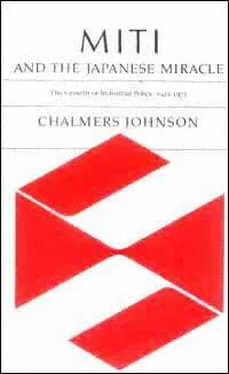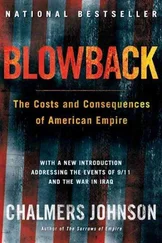Chalmers Johnson - MITI and the Japanese miracle
Здесь есть возможность читать онлайн «Chalmers Johnson - MITI and the Japanese miracle» весь текст электронной книги совершенно бесплатно (целиком полную версию без сокращений). В некоторых случаях можно слушать аудио, скачать через торрент в формате fb2 и присутствует краткое содержание. Год выпуска: 2007, Издательство: Stanford University Press, Жанр: Старинная литература, на английском языке. Описание произведения, (предисловие) а так же отзывы посетителей доступны на портале библиотеки ЛибКат.
- Название:MITI and the Japanese miracle
- Автор:
- Издательство:Stanford University Press
- Жанр:
- Год:2007
- ISBN:нет данных
- Рейтинг книги:3 / 5. Голосов: 1
-
Избранное:Добавить в избранное
- Отзывы:
-
Ваша оценка:
- 60
- 1
- 2
- 3
- 4
- 5
MITI and the Japanese miracle: краткое содержание, описание и аннотация
Предлагаем к чтению аннотацию, описание, краткое содержание или предисловие (зависит от того, что написал сам автор книги «MITI and the Japanese miracle»). Если вы не нашли необходимую информацию о книге — напишите в комментариях, мы постараемся отыскать её.
MITI and the Japanese miracle — читать онлайн бесплатно полную книгу (весь текст) целиком
Ниже представлен текст книги, разбитый по страницам. Система сохранения места последней прочитанной страницы, позволяет с удобством читать онлайн бесплатно книгу «MITI and the Japanese miracle», без необходимости каждый раз заново искать на чём Вы остановились. Поставьте закладку, и сможете в любой момент перейти на страницу, на которой закончили чтение.
Интервал:
Закладка:
As for Shirasu, after failing to be appointed ambassador to the United States, which he had wanted, he left politics and in May 1951 became president of the Tohoku* Electric Power Company. He and Yoshida had had a parting of the ways. In 1974, for the first time in many years, Shirasu's name was again mentioned in the press. The
Japan Times
reported on August 19 that as the director of the exclusive Karuizawa Golf Club and chairman of its course committee, he refused to allow former American ambassador Robert Ingersoll to play a round on a weekend, even though Ingersoll presented a letter of introduction from Prime Minister Tanaka Kakuei. The rules of the Karuizawa Club prohibit visitors from playing on weekends, and Shirasu stuck to the rules. In order to become a member of the club, one must own a villa in Karuizawa.
The last minister of MCI and the first minister of MITI, Inagaki Heitaro* (an industrialist from the old Furukawa zaibatsu, the president of Yokohama Rubber, and a member of the House of Councillors), made a speech at the time of MITI's inauguration. He pledged the new ministry to international trade and export promotionor "trade number one-ism" (
tsusho
*
daiichi-shugi
) as he put it.
61
Inagaki added, however, that an increase in production, the rationalization of enterprises, and the raising of the technical level of industry were all prerequisite to an expansion of trade. He entrusted these vital tasks to the Enterprises Bureau, the only internal bureau he mentioned by name. The old MCI cadres found this very satisfactory. For almost a decade they had not paid much attention to trade and certainly not to export promotion. But the new ministry seemed to offer great opportunities for
Page 194
their skills, and industrial guidance in the name of trade promotion seemed like a better and more secure basis for their existence than war production or postwar rationing. The future was looking brighter.
During 1949 SCAP began a policy of transferring some of its own controlling and supervisory powers to the Japanese government in anticipation of the coming peace treaty. On February 2, 1949, the occupation delegated to the Japanese government all control over foreign exchange accruing from international trade, and it ordered the creation of a Foreign Exchange Control Board to supervise the investment of these funds in industries that were essential to Japan's economic recovery. To complete the transfer of authority, SCAP encouraged the Japanese government to pass the Foreign Exchange and Foreign Trade Control Law (number 228 of December 1, 1949).
62
Among other things, this law required that any citizen who acquired foreign exchange through trade must turn it over to a government account, and the Foreign Exchange Control Board was put in charge of how these funds would be used. Until the end of the occupation the ESB drew up periodic foreign exchange budgets to spend the foreign exchange thus concentrated, but on August 1, 1952, both the ESB and the Foreign Exchange Control Board were abolished. Their powers to enact and supervise the foreign exchange budget were transferred to the newly created Budget Section of MITI's International Trade Bureau. At the same time the powers of the ESB's old Foreign Capital Committee to supervise all imports of technology and all joint ventures were transferred to the Industrial Finance Section of the Enterprises Bureau.
63
When these changes were made, MITI came to possess weapons of industrial management and control that rivaled anything its predecessors had ever known during the prewar and wartime periods.
SCAP believed that the Foreign Exchange and Foreign Trade Control Law of December 1949 was merely temporary. As it wrote in one of its official histories:


This broad enabling act authorized the Government to maintain a unified system of control over foreign exchange and foreign trade transactions only to the extent necessary to safeguard the balance of international payments, and in effect transferred to the Government certain responsibilities which had been exercised by SCAP since the beginning of the occupation. The restrictions in the law were to be gradually relaxed by cabinet orders and ministerial ordinances as the need for them subsided.
64
Far from being "gradually relaxed," the law persisted for the next thirty years and was still on the books during 1980; it was the single
Page 195
most important instrument of industrial guidance and control that MITI ever possessed. As Leon Hollerman put it from the perspective of 1979, "In liquidating the occupation by 'handing back' operational control to the Japanese, SCAP naively presided not only over the transfer of its own authority but also over the institutionalization of the most restrictive foreign trade and foreign exchange control system ever devised by a major free nation."
65
In the next chapter we shall turn to what the officials of MITI did with these and other new powers.
Virtually all Japanese regard the defeat of 1945 as the most important watershed in modern Japanese history since the Meiji Restoration of 1868. However, from the point of view of the history of industrial policy, I believe that the 1940's are one continuous era: the period of the high tide of state control. Beginning with the policies of the Tojo* government and continuing with their acceleration by SCAP, the Japanese state came to dominate virtually all economic decisions, from those of zaibatsu enterprises to those of individual households. Tojo and his associates intended this outcome but were unable to achieve it completely; the Allied reformers did not intend it but promoted it anyway, first out of their commitment to making the government more responsible, and subsequently out of their commitment to Japanese economic recovery and growth as part of the renewed global resistance to totalitarianism. The prime political beneficiaries of these developments were the economic bureaucrats; the ultimate economic beneficiaries were the Japanese people.
The longer-range significance of the achievement of state control, however, was to reveal its weaknesses. The fundamental political problem of the state-guided high-growth system is that of the relationship between the state bureaucracy and privately owned businesses. If this relationship is overbalanced in favor of one side or the other, it will result in either the loss of the benefits of competition or the dilution of the state's priorities. State control refers to the attempt to separate management from ownership and to put management under state supervision. Whereas big business typically prefers self-imposed control, economic bureaucrats typically prefer state control. During the 1940's, when state control was achieved, its weaknessesthe growth of bureaucracy, irresponsible management, corruption, and lowered efficiencywere also fully manifested. The result was that just as the deficiencies of self-control under the Important Industries Control Law of 1931 led to the movement toward state control, the deficiencies of state control under the Ministry of Munitions and
Page 196
the postwar MCI led to the government-business relationship of the high-growth erathat is, to genuine public-private cooperation.
True state control did not last long after 1949. Its primary contribution to the later high-growth system was the irreversible establishment of the economic general staff at the heart of all Japanese economic policy-making and administration. In the years after the occupation the economic bureaucracy began by degrees to share its powers with big business, consulting it on all important issues, providing state incentives for industrial rationalization, and blurring the distinctions between the state and the private sector by insinuating numerous ex-bureaucrats into the board rooms of the economically strategic industries.
Читать дальшеИнтервал:
Закладка:
Похожие книги на «MITI and the Japanese miracle»
Представляем Вашему вниманию похожие книги на «MITI and the Japanese miracle» списком для выбора. Мы отобрали схожую по названию и смыслу литературу в надежде предоставить читателям больше вариантов отыскать новые, интересные, ещё непрочитанные произведения.
Обсуждение, отзывы о книге «MITI and the Japanese miracle» и просто собственные мнения читателей. Оставьте ваши комментарии, напишите, что Вы думаете о произведении, его смысле или главных героях. Укажите что конкретно понравилось, а что нет, и почему Вы так считаете.












